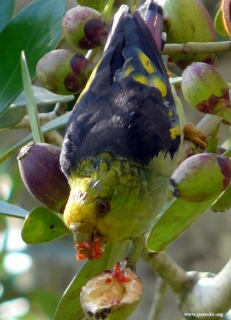Lilac-tailed Parrotlet |
|
|
Also known as: Seven-colored Parrotlet, Black-winged Parrotlet, Scopoli's Parrotlet
Photos
View in GalleryDid You Know?
The Lilac-tailed Parrotlet nests in an arboreal termitarium (termite mound in a tree).Academic Research
Related publications: Touit batavicusSpecies Profile
Genus: Touit | Species: batavicus
Size:
14cm (5.5 in)
Weight:
58-72g (2-2.5 oz)
Subspecies including nominate:
one
Colour Adult:
Both adults green/yellow head; brighter yellow with black scalloping on face and nape to sides of neck; black upperparts; rose/red carpal edge; pale blue foreneck tinted green; pale blue/green breast mixing into yellow/green on abdomen to undertail coverts; blue underwing coverts marked with yellow and red near to carpal edge and bordered with black along leading edge; purple central tail feathers; lateral tail feathers purple/lilac and barred with black near tip. Bill olive/yellow with grey at base. Eye ring grey. Eye yellow.
Colour Juvenile:
As in adults.
Call:
Calls made in flight are soft and nasal, rising to a high-pitched, whining sound. Before taking flight emits weak, nasal calls, and short trilling or chattering notes.
Listen NowMore Information:
Content Sources:
CITES
BirdLife International
Cornell Lab of Ornithology/Birds of the World
Parrots: A Guide to Parrots of the World, Juniper and Parr, 1998
ML Media Collection Catalogue 8546, Lilac-tailed Parrotlet Touit batavica, Snow, David, Trinidad and Tobago, May 16 1959, Cornell Lab of Ornithology. Site
Parrots of the World, Forshaw and Cooper, 1989. 2010 edition
Parrots of the World, Forshaw, 2006.
Parrots in Aviculture, Low, 1992.
Photos
View in GalleryDid You Know?
The Lilac-tailed Parrotlet nests in an arboreal termitarium (termite mound in a tree).Academic Research
Related publications: Touit batavicusSpecies Care
Captive Status:
Not usually seen in captivity.
Longevity:
Not recorded.
Housing:
Keep indoors in minimum temperature 20C (68 F), minimum length 2.1m (7 ft).
Diet:
Lory formula; flowers and buds; tropical fruits such as: mango, guava, papaya; other fruits such as: apple, pear, oranges, pomegranate, cactus fruits; vegetables such as: carrot, celery, green beans and peas in the pod; green leaves such as: Swiss chard, lettuce, sowthistle, dandelion, chickweed; fresh rose hips, elder and mountain ash berries; sprouted seed mix of safflower, millet, oats, hemp and some sunflower; mineral supplements; fresh non-toxic branches.
Enrichment:
Provide unsprayed, bird-safe variety of branches.
Nest Box Size:
Not recorded.
Clutch Size:
5-6
Incubation Time:
Not recorded.
Fledging Age:
Not recorded.
Hatch Weight:
Not recorded.
Peak Weight:
Not recorded.
Weaning Weight:
Not recorded.
Photos
View in GalleryDid You Know?
The Lilac-tailed Parrotlet nests in an arboreal termitarium (termite mound in a tree).Academic Research
Related publications: Touit batavicusSpecies Wild Status
World Population:
Unknown, decreasing.
IUCN Red List Status:
Least Concern
CITES Listing:
Appendix II
Threat Summary:
Not globally threatened. Relatively common on Trinidad. Heavily traded in Venezuela; one source describes it as difficult to keep in captivity due to high mortality.
Range:
Trinidad, Guianas, and possibly Amapa, N Brazil; also scattered across N Venezuela, reaching N Colombia.
Habitat:
Found up to 1700m (5576 ft) in primary forest or taller secondary growth in tropical and subtropical zones; also may be seen lower down at forest edge and at clearings in dry deciduous and humid forest.
Wild Diet:
Feeds on flowers, nectar, buds, berries, seeds and fruits.
Ecology and Behaviour:
Seen generally in flocks of 10-30 individuals or more outside breeding season. Highly social when feeding and at roost. Keeps to upper stages of canopy, but comes lower in fruiting trees. Continuous chattering while flight.
Clutch and Egg Size:
5-6 almost spherical eggs, 22.0 x 19.5mm (0.9 x 0.7 in).
Breeding Season:
January-March, Trinidad; December Surinam. Nest is in arboreal termitarium or hollow limb.
Photos
View in GalleryDid You Know?
The Lilac-tailed Parrotlet nests in an arboreal termitarium (termite mound in a tree).Academic Research
Related publications: Touit batavicusMembers Only Resources
Please log-in now to find more research, resources and tools.
Not a Member?
Find more great information:
Gain exclusive access to 600+ pages of additional research, seminars and podcasts, specialists to ask your toughest questions, and dozens of other fun resources - when you become a WPT member.
Join Today >>

































